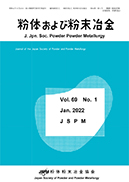
- |<
- <
- 1
- >
- >|
-
Kiyoshi MIZUUCHI2022Volume 69Issue 11 Pages 441-454
Published: November 15, 2022
Released on J-STAGE: November 15, 2022
JOURNAL OPEN ACCESSWe have investigated a series of high performance metal-matrix composites (MMCs), in order to improve mechanical and thermal properties of such composites. To fabricate such composites, we have used spark plasma sintering (SPS) process. Using this processing, we would minimize or avoid some risks in damaging filler surfaces during processing. In this article, also introduced are various kinds of MMCs, metal/intermetallic laminate materials, fiber reinforced composites and particle dispersed heat dissipative materials. These composites have been fabricated using various methods, such as, vacuum hot pressing, diffusion bonding and metal infiltration, and their physical properties are shown and well documented. In the article, MMCs fabricated by our SPS method is compared to those fabricated by other fabrication methods. This review article leads to strong indications regarding fabrication techniques for making better MMCs.
View full abstractDownload PDF (3896K)
-
Shinji NAKAI, Takeshi WAKI, Yoshikazu TABATA, Masaki KATO, Hiroto OHTA ...2022Volume 69Issue 11 Pages 455-460
Published: November 15, 2022
Released on J-STAGE: November 15, 2022
JOURNAL OPEN ACCESSMe-substituted W-type ferrites (AMe2Fe16O27 with A = Sr, Ba, …, and Me = Co, Ni, Zn, Mg, …) can be obtained by standard solid state reaction but always contain secondary phases. Phase stability of SrMe2Fe16O27 with Me = Co, Ni, Zn, and Mg sintered in various oxygen pressures of pO2 = 0.2, 1, 10 and 387 atm were investigated using X-ray diffraction analysis, wavelength-dispersive X-ray (WDX) analysis, and transmission electron microscopy (TEM). WDX analysis revealed that the W-type ferrites are described as SrMe2-δFe16+δO27 because Fe3+ is partially reduced to Fe2+ even when synthesis is initiated from SrMe2Fe16O27. Increasing the oxygen pressure suppresses the reduction of Fe3+ and the formation of the secondary phases. In addition, TEM analysis shows that the SrCo2Fe16O27 single crystal is free of stacking faults. We conclude that the single-phase formation of the Me-substituted W-type ferrites is hampered by the discrepancy between initial and actual chemical composition caused by the appearance of Fe2+.
View full abstractDownload PDF (1311K) -
Taiki SHIOTANI, Hiroto OHTA, Takeshi WAKI, Yoshikazu TABATA, Hiroyuki ...2022Volume 69Issue 11 Pages 461-466
Published: November 15, 2022
Released on J-STAGE: November 15, 2022
JOURNAL OPEN ACCESSWe studied a solid-solution system of the transition-metal pnictide, Y2(MnxFe1−x)12P7, with the Zr2Fe12P7-type structure, which has two kinds of transition metal sites: three tetrahedral sites and a pyramidal site. We successfully obtained polycrystalline samples of Y2(MnxFe1−x)12P7 in the range of 0 ≦ x ≦ 0.9. The lattice parameter along the a-axis monotonically increases with the Mn substitution, while that along the c-axis is nearly constant. 57Fe Mössbauer spectroscopy shows that Mn atoms prefer to occupy the pyramidal site. At x = 0.25, the site-ordered compound, Y2Mn3Fe9P7, was obtained, where Mn atoms occupy the pyramidal site and Fe atoms occupy the tetrahedral sites. The magnetization of Y2Mn3Fe9P7 exhibits an anomaly at approximately 60 K, suggesting presence of an antiferromagnetic transition, which originates from the magnetic moment of Mn at the pyramidal site.
View full abstractDownload PDF (1050K) -
Kodai MORIYAMA, Joichi MURAKAWA, Hibiki KANAGAWA, Chishiro MICHIOKA, H ...2022Volume 69Issue 11 Pages 467-474
Published: November 15, 2022
Released on J-STAGE: November 15, 2022
JOURNAL OPEN ACCESSFerromagnetic spin fluctuations in itinerant-electron magnetic compounds RCo9Si4 (R = Y, La) were investigated by using magnetization and 59Co-NMR measurements. YCo9Si4 is an itinerant ferromagnet, while LaCo9Si4 is a nearly ferromagnetic metal. In YCo9Si4, the field dependence of the magnetization is well described by Takahashi’s spin-fluctuation theory for weak itinerant ferromagnets. In both YCo9Si4 and LaCo9Si4, the magnetic susceptibility, the Knight Shift and 1/T1T show a similar temperature dependence, which suggests that the ferromagnetic spin fluctuation is dominant in these compounds. The difference in the magnetic ground state of these compounds is possibly attributed to the fact that the energy scale of the ferromagnetic spin fluctuation in LaCo9Si4 is larger than that in YCo9Si4.
View full abstractDownload PDF (1322K)
-
2022Volume 69Issue 11 Pages Pref11_1
Published: November 15, 2022
Released on J-STAGE: November 15, 2022
JOURNAL OPEN ACCESSDownload PDF (501K) -
2022Volume 69Issue 11 Pages Mtg10_6-Mtg10_14
Published: November 15, 2022
Released on J-STAGE: November 15, 2022
JOURNAL OPEN ACCESSDownload PDF (252K) -
2022Volume 69Issue 11 Pages 475
Published: November 15, 2022
Released on J-STAGE: November 15, 2022
JOURNAL OPEN ACCESSDownload PDF (343K)
- |<
- <
- 1
- >
- >|